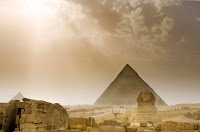Pyramids of Giza
Of all the original Seven Wonders of the Ancient World, only one is still standing: the Great Pyramid of Cheops. Granted, its pinnacle was lopped off, and the polished white limestone that once faced its sloping sides was scavenged ages ago. But there it is in the Egyptian desert, the largest in a trio of stupendous royal tombs, with a quirky monument called the Sphinx alongside. It's quite a sight to see — if only you could see it.
Today, aggressive throngs of souvenir vendors, tour touts, and taxi drivers crowd the entrance to the Pyramids of Giza. Though camel rides and horseback tours are now banned from the monument area, visitors still clamber unchecked over the ancient landmarks. The haphazard sprawl and pollution of Cairo comes right to the edge of the archaeological zone, yet Egyptian officials seem unconcerned about protecting the site.
It's difficult now to get that iconic long-distance view of the three pyramids looming in the desert; you can't really see them until you're too close. Oriented precisely to the points of the compass, they were built for three Pharaohs of the 4th Dynasty (about 27th c. B.C.) — the Great Pyramid of Cheops, the slightly smaller Second Pyramid of Chephren, and the much smaller red-granite Third Pyramid of Mycerinus — and designed to imitate the rays of the sun shining down from its zenith. Most tourists expect a visit to the famed pyramids to be a once-in-a-lifetime thrill, not a tawdry letdown. It's the only Ancient Wonder we have left — what a pity it's come to this.
Click to enlarge pictures (Open in new window)
More Places to See Before They Disappear
Today, aggressive throngs of souvenir vendors, tour touts, and taxi drivers crowd the entrance to the Pyramids of Giza. Though camel rides and horseback tours are now banned from the monument area, visitors still clamber unchecked over the ancient landmarks. The haphazard sprawl and pollution of Cairo comes right to the edge of the archaeological zone, yet Egyptian officials seem unconcerned about protecting the site.
It's difficult now to get that iconic long-distance view of the three pyramids looming in the desert; you can't really see them until you're too close. Oriented precisely to the points of the compass, they were built for three Pharaohs of the 4th Dynasty (about 27th c. B.C.) — the Great Pyramid of Cheops, the slightly smaller Second Pyramid of Chephren, and the much smaller red-granite Third Pyramid of Mycerinus — and designed to imitate the rays of the sun shining down from its zenith. Most tourists expect a visit to the famed pyramids to be a once-in-a-lifetime thrill, not a tawdry letdown. It's the only Ancient Wonder we have left — what a pity it's come to this.
Click to enlarge pictures (Open in new window)
More Places to See Before They Disappear







1 comment:
Interesting post.
Post a Comment